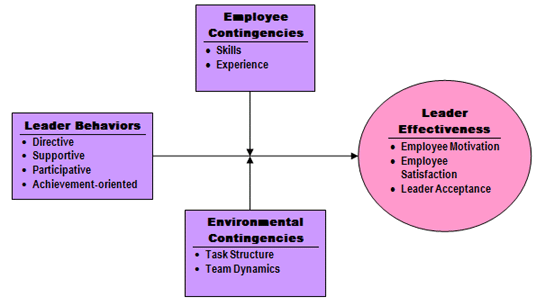The theory was developed by Robert J. House and has its roots in the expectancy theory of motivation. The theory is based on the premise that an employee’s perception of expectancies between his effort and performance is greatly affected by a leader’s behavior. The leaders help group members in attaining rewards by clarifying the paths to goals and removing obstacles to performance. They do so by providing the information, support, and other resources which are required by employees to complete the task.
Robert J. House, founder of Path-Goal theory, believes that a leader’s behavior is contingent to employee satisfaction, employee motivation and employee performance. Path-Goal theory states that a good leader provides clear direction, sets high goals, gets involved in goal achievement and supports his employees. The employees, as a result, will be a more satisfied and productive team. It also states that employees will accept a leader’s direction if the employee believes that there will be an immediate or future benefit that results from work.
House’s theory advocates servant leadership. As per servant leadership theory, leadership is not viewed as a position of power. Rather, leaders act as coaches and facilitators to their subordinates. According to House’s path-goal theory, a leader’s effectiveness depends on several employee and environmental contingent factors and certain leadership styles. All these are explained in the figure 1 below:

Leadership Styles
The four leadership styles are:
- Directive
Here the leader provides guidelines, lets subordinates know what is expected of them, sets performance standards for them, and controls behavior when performance standards are not met. He makes judicious use of rewards and disciplinary action. The style is the same as task-oriented one.
- Supportive
The leader is friendly towards subordinates and displays personal concern for their needs, welfare, and well-being. This style is the same as people-oriented leadership.
- Participative
The leader believes in group decision-making and shares information with subordinates. He consults his subordinates on important decisions related to work, task goals, and paths to resolve goals.
- Achievement-oriented
The leader sets challenging goals and encourages employees to reach their peak performance. The leader believes that employees are responsible enough to accomplish challenging goals. This is the same as goal-setting theory.
According to the theory, these leadership styles are not mutually excusive and leaders are capable of selecting more than one kind of a style suited for a particular situation.
Contingencies
The theory states that each of these styles will be effective in some situations but not in others. It further states that the relationship between a leader’s style and effectiveness is dependent on the following variables:
- Employee characteristics
These include factors such as employees’ needs, locus of control, experience, perceived ability, satisfaction, willingness to leave the organization, and anxiety. For example, if followers are high inability, a directive style of leadership may be unnecessary; instead a supportive approach may be preferable.
- Characteristics of work environment
These include factors such as task structure and team dynamics that are outside the control of the employee. For example, for employees performing simple and routine tasks, a supportive style is much effective than a directive one. Similarly, the participative style works much better for non-routine tasks than routine ones.
When team cohesiveness is low, a supportive leadership style must be used whereas in a situation where performance-oriented team norms exist, a directive style or possibly an achievement-oriented style works better. Leaders should apply directive style to counteract team norms that oppose the team’s formal objectives.
The theory has been subjected to empirical testing in several studies and has received considerable research support. This theory consistently reminds the leaders that their main role as a leader is to assist the subordinates in defining their goals and then to assist them in accomplishing those goals in the most efficient and effective manner. This theory gives a guide map to the leaders about how to increase subordinates satisfaction and performance level.
One thought on “Path Goal Theory”